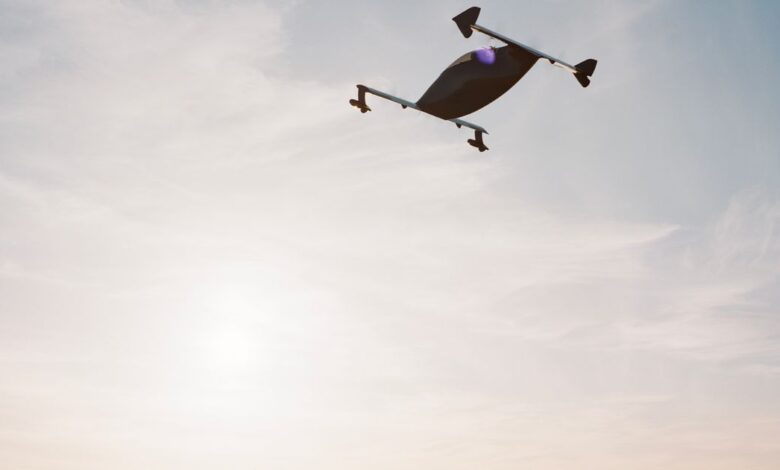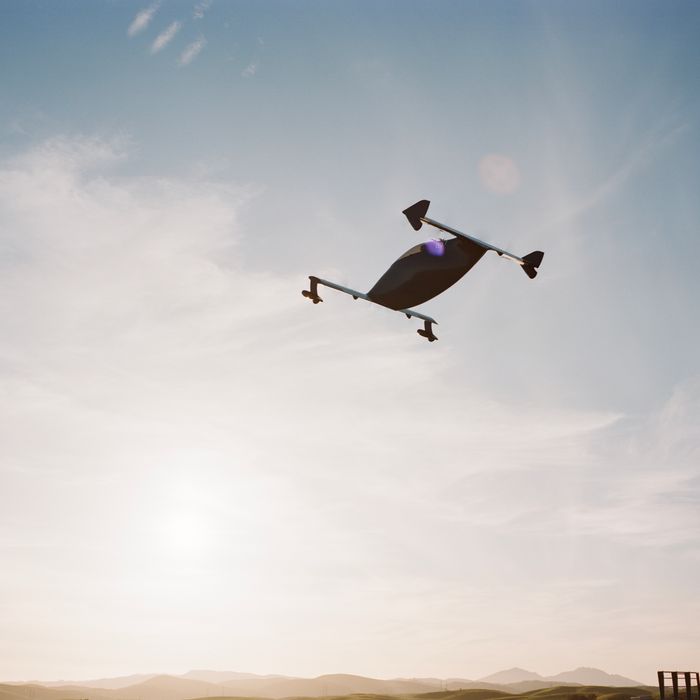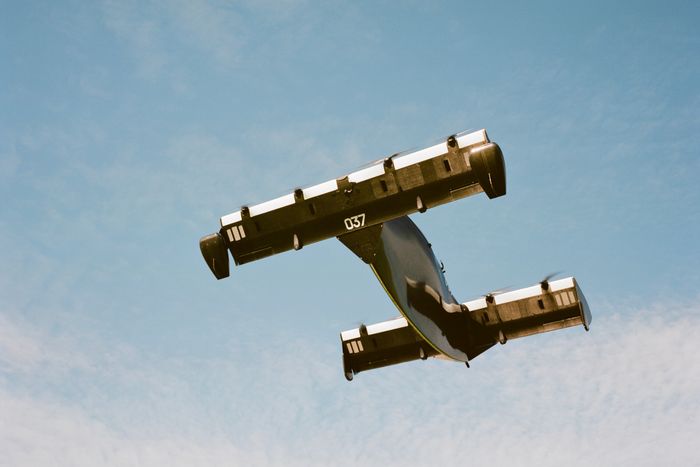

The BlackFly Generation 3 aircraft over Byron Airport in California.
Photo: Balazs Gardi
Most mornings, when the air lies still on the ridges of the North Cascades in central Washington State, Tim Lum climbs into his personal flying car, a 14-foot-long bean-shaped craft called a BlackFly, straps himself in, and sets the machine’s four rotor blades whirring. As the 61-year-old retired smoke jumper levitates into the crepuscular sky, the landscape opens up below him, the forest stretching along the ridge and the farmland sprawling across the valley floor below. The aircraft swings forward into horizontal flight, and Lum zips off, flowing along the contours of the land, taking in the scenery. “It’s stunning, very dramatic,” he tells me later. “Cliffs and trees and valleys.”
I’ve been writing paragraphs like this for decades for magazines like Popular Mechanics and Popular Science, imagining a time in the not-so-distant future when the long-awaited promise of flying cars — more officially known as electric vertical-takeoff-and-landing vehicles, or EVTOL — is finally made a reality. This time, though, the scene is not a flight of fancy. Lum is a real person, and he really does fly a personal flying machine, typically around five times a day.
If you have $190,000 on hand, you, too, could buy one — or, if your budget is more modest, you can book a rental ride in a different kind of electric flying vehicle for $249. At long last, the era of the flying car is here.
But there is a catch: The EVTOLs that are currently available are not, strictly speaking, legal. The entire fledgling industry, such as it is, exists in a kind of shadowland, where it’s unclear what exactly the rules are and what will happen if you break them. For the manufacturers, it’s a gamble, the kind of regulatory arbitrage that could allow them to jump ahead of more careful, rule-following competitors and become an industry-dominating colossus like Airbnb or Uber or could devolve into lawsuits and enforcement actions. “Move fast and break things” is the Silicon Valley way, but it’s very much the opposite of the safety-first mind-set of the rest of the aviation industry, where if things crash and burn, they do so literally — and the public and government are not quick to forgive.
The vision for today’s EVTOL market came to Matt Chasen, a former Boeing engineer turned entrepreneur, in 2017. He was attending a conference where the latest models were being discussed — the six-engine tilt rotor being developed by Joby of California, the EHang 184-passenger drone from China, and Germany’s Lilium Eagle, among others. Able to take off and land just about anywhere, this class of aircraft had the potential to revolutionize travel. Investors had poured billions of dollars into hundreds of different prototypes. Everyone seemed to agree that it was only a matter of time before flying cars were whizzing back and forth across the landscape. Chasen saw a major problem, though, an insurmountable engineering hurdle that would keep the whole field from being viable for a long time. It was all about battery life.
One of the basic rules of aviation safety is that you have to have enough fuel in your aircraft to take you where you want to go and then some. If you can’t carry that extra fuel, you can’t make the trip. In the U.S., the Federal Aviation Administration requires that aircraft carry enough fuel to fly for another 30 minutes. But the most advanced EVTOLs Chasen saw at the time didn’t have enough energy storage to stay aloft for 30 minutes total. Sure, battery capacity is destined to improve, but when the best aircraft available aren’t able legally to stay aloft for even zero minutes, you’ve got a deep baked-in problem.
Chasen perceived a solution. He knew that the FAA doesn’t have just one standard of certification but several, depending on the amount of public risk involved. Commercial airline operations, which could kill hundreds of people through a single mishap, are very tightly regulated with strict requirements for pilot training and aircraft certification. Small planes used for personal use have much laxer rules. And at the very low end of FAA certification, there is a little area where there are no rules at all.
Tim Lum takes off in his BlackFly.
Part 103 applies to ultralight aircraft that weigh less than 254 pounds, carry only a single occupant, are used for strictly recreational purposes, and meet a few other criteria. Under Part 103, the FAA doesn’t need to certify such an aircraft as safe and you don’t need a pilot’s license to fly it. The aircraft doesn’t get a tail number, and if you crash and die using it, no government inspectors will come to pick through the wreckage to figure out what went wrong.
“It’s a wonderful regulation,” Chasen says. “The FAA basically decided, ‘Hey, this is America. We don’t ban people from skydiving, rock climbing, or racing cars. You can do whatever you want, right? It may put you in some danger. That’s up to you. That’s your own personal tradeoff.’ All of the rules for Part 103 are about not putting people on the ground or other people in the air at risk.”
If Chasen could build an EVTOL that qualified as a Part 103 ultralight, he wouldn’t need to worry about the reserve-fuel requirement or about any of the other regulatory hoops that manufacturers normally stress over. And he could market it to the vast proportion of the population that doesn’t have a pilot’s license.
Chasen started a company called LIFT, which then built an aircraft called Hexa. It measures 15 feet high and across with a rack of 18 propellers over a podlike cockpit. It’s a cool-looking and capable aircraft, able of reaching a cruise speed of 45 mph. But it has a problem from the FAA’s perspective. The Hexa weighs 432 pounds, about 178 pounds too much to qualify under Part 103.
LIFT’s answer was to take a magnifying glass to the regulations. It found that there was a weight allowance for safety equipment, including 30 pounds for floats. By attaching five floats to the aircraft, it figured it had earned itself enough of an allowance to get back under the maximum weight.
There was another obstacle. Part 103 forbids using ultralights for any commercial purpose, which rules out a lot of business models. But, again, LIFT found a loophole. While it couldn’t sell rides in its ultralight, it could rent them for other people to use. So it came up with the idea of operating the aircraft as a kind of carnival ride, selling 12-to-15-minute flights for $249. Customers complete a brief training session, then get into the Helix and use the joystick to climb and roam within a small defined volume of air over a field. To date, Chasen says, “somewhere between 300 and 500 people have flown.”
Meanwhile, an inventor named Marcus Leng was also looking for a way into the market. He had built a podlike aircraft called the BlackFly, which is borne aloft by four propellers like an Osprey and can take off vertically and then transition into forward flight. The invention attracted investors and gave rise to a Palo Alto–based company called Pivotal.
Instead of selling rides, Pivotal started selling whole aircraft. And unlike every other EVTOL startup that has talked about doing that, and in some cases even started accepting deposits, Pivotal has actually begun delivering airframes, with Tim Lum being customer No. 1.
He is a unicorn from a customer-demographic perspective. He’s divorced (“unscathed,” he says), has no kids, and has made a habit of living beneath his means; he lives in the mountains in a house he’s building himself. Having retired from the U.S. Air Force Reserve and from a follow-on career as a wildlands firefighter, he’s all set financially. Basically, he’s an unattached free spirit with money to spend. The idea of wandering around the sky by himself suits him just fine.
Not that many people check all of those boxes. People who love to fly, and have lots of time and money on their hands, might get their pilot’s license and fly around in a more conventional, more capable airplane or helicopter. They might want to carry friends or loved ones along with them, and they might prefer to entrust their life to a certified aircraft. They might not want to spend their money on what amounts essentially to an expensive toy.
Someday, the situation might change. The range of potential customers might expand as EVTOLs find more practical use cases. LIFT and Pivotal both foresee a future in which aircraft like theirs can be summoned by a mobile app, land almost anywhere, and whisk customers away on short hops, especially across urban bodies of water like the San Francisco Bay. But there are a lot of regulatory and technical hurdles that will need to be overcome before then, not least the development of autopilots that can be trusted to operate in complex, dynamic environments without killing anybody.
Pivotal received a major publicity coup this past April when it was featured in a long article by New Yorker writer Gideon Lewis-Kraus, who underwent flight training and then took a test flight. “As I took off into a hover, I twisted the stick to the right, turning away from everyone below, and lit out in the direction of the hills,” he reported. “Once I levelled off, the propellers quieted to a much softer hum, and all at once I had a feeling of lightness and agility in the air.”
The BlackFly Generation 3 aircraft.
Photo: Balazs Gardi
What Lewis-Kraus didn’t address in his piece was whether his flight in the Helix was legal. He noted the weight of the aircraft — less than 350 pounds — but not that this significantly exceeded the maximum allowable weight for a Part 103 aircraft, by 94 pounds. Pivotal is aware of the issue; on its website, it makes the case that, like the LIFT Hexa, its aircraft are equipped with floats and a watertight hull that afford it an extra-weight allowance.
What this argument elides is that that float weight exemption is intended for aircraft designed to regularly operate on water, which neither the Hexa or the Blackfly are. Lum says that the floats on his Blackfly are there “for emergency use only. The aircraft has to be serviced before I can fly it again after a water landing.” Chasen says that “our floats will be very useful in the event that you need to make an emergency landing … we’re not planning on doing normal operations to and from the water.”
This isn’t a minor technicality but a fundamental disqualification. Part 103 is quite clear that an aircraft must meet each and every one of its criteria in order to operate under ultralight rules. “The FAA realizes that it is possible to design an ultralight which, on paper, meets the requirements of [Part 103], but in reality does not,” it says. “If you fail to meet any one of the elements, you may not operate under Part 103.”
There is something surreal in the way that an EVTOL hangs in the air, as though in willful defiance of gravity, or perhaps just temporarily ignorant of it, like Wile E Coyote after he has stepped off a cliff and before he realizes there is no solid ground under his feet. One gets a similar sense of precarity when contemplating the legality of the aircraft.
I reached out to the FAA to ask who would bear responsibility. “The onus is on the owner/operator to follow the applicable regulations,” a spokesperson responded by email. “If someone buys an aircraft that’s marketed as an ultralight, but isn’t a true ultralight, they must comply with the regulations that apply to the type of aircraft it actually is. This includes, but is not necessarily limited to, getting an airworthiness certificate for the aircraft and an appropriate pilot certificate.”
And what would happen, I asked, if they didn’t?
“Our goal is to get people to comply with the regulations,” the spokesperson replied. “Speaking generally, if we became aware of a pilot who was operating a non-ultralight as an ultralight, we likely would counsel them and explain the regulations they need to follow. If after counseling a pilot refused to comply, we could pursue legal enforcement action. In the case of someone who doesn’t hold an FAA-issued pilot certificate, the legal action would be to propose a civil penalty” — in other words, a fine.
What this means as a practical matter is that someone like Tim Lum can spend hundreds of thousands of dollars buying an EVTOL and fly it from his private property to his heart’s content. But there the FAA could always show up one day, demand to test the aircraft, and declare that it cannot be legally operated under Part 103. Since there are currently no regulations under which an aircraft of that type can be certified, he would either have to stop flying it or risk being fined.
This might seem like a silly state of affairs. If someone wants to spend their money hopping around over sparsely populated terrain, one well might ask what the harm is.
From the FAA’s perspective, the answer is that the regulations were established to prevent people from falling victim to risks that they didn’t understand. Keeping ultralight aircraft below a certain weight, and capable of only low performance, isn’t just intended to limit damage to people and structures on the ground. It’s to make sure that this kind of anything-goes Wild West aviation remains a fringe activity, limited to people who are fully informed about the risks they’re taking.
When it wrote the rules for ultralight aircraft, the FAA appears to have been keenly aware of the potential for abuse. The rules explicitly warn that if the agency comes to feel that its liberality is being taken advantage of, it may have to crack down: “The actions of the ultralight community will affect the direction Government takes in future regulations … The ultralight community is encouraged to adopt good operating practices and programs in order to avoid more extensive regulation.”
To get the perspective of the pilot community I reached out to the Aircraft Owners and Pilots Association (AOPA) and spoke with Tom Zecha, the senior manager of the group’s Pilot Information Center, a call-in facility that offers technical and professional advice to its members. Zecha hadn’t heard of EVTOL’s Part 103 problems, but when I described them to him he sounded incredulous. Though the legal responsibility for operating an aircraft lies with the pilot, he finds it hard to believe that in the case of a fatal accident the manufacturer wouldn’t face tremendous legal exposure: “If somebody bought one of these and they killed themselves in it, the liability … that’s going to put an end to them right there. It will just kill them.”
But until something like that happens, he guessed that nothing will be done. LIFT and Pivotal benefit from a Catch-22 aspect of the ultralight regulatory structure, which is that since the FAA is explicitly uninterested in policing that corner of aviation, it’s also uninterested in checking whether those who are in it really should be or not. “How does it get on the FAA’s radar? There’s no certification process,” Zecha points out. “There’s nothing to draw the FAA’s attention to it.”
Source link





